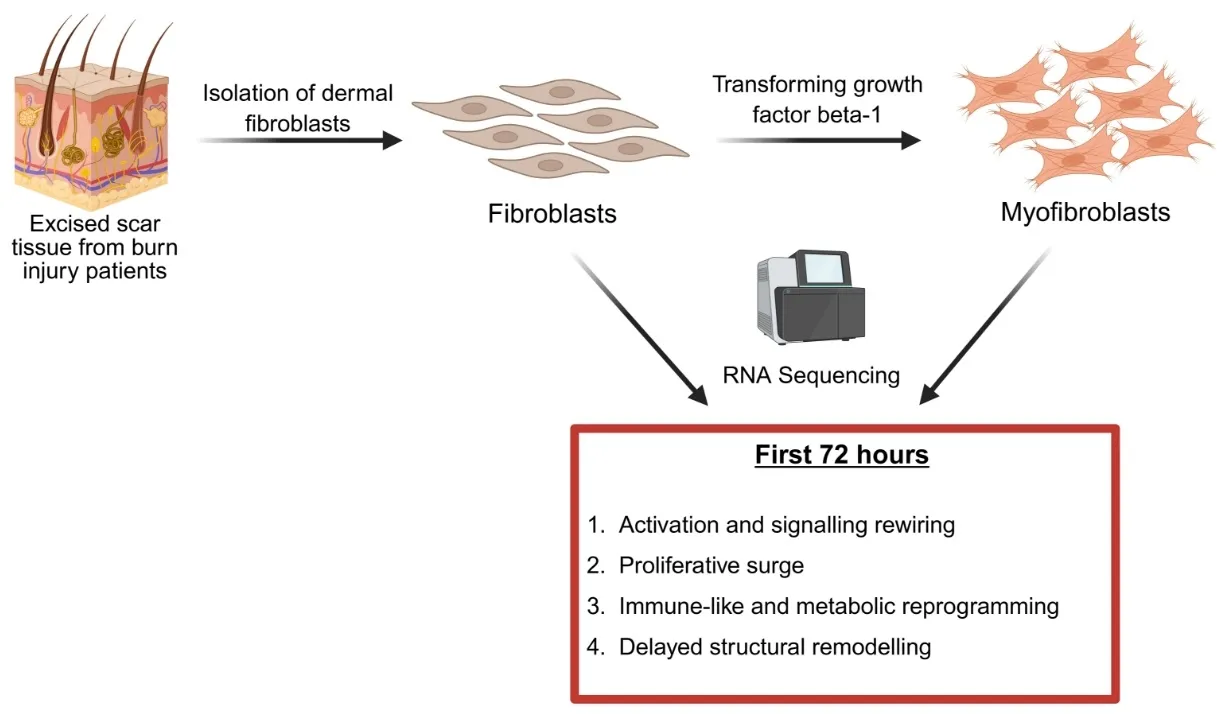Open Access
Article
09 October 2025Identification of Pathways That Drive Myofibroblast Transformation in Hypertrophic Scars
Hypertrophic scars (HTS) are a common complication of burn injuries and are characterized by excessive dermal fibrosis driven by the transformation of resident dermal fibroblasts to profibrotic myofibroblasts. Although single cell and bulk RNA transcriptomics analysis of HTS and normal skin tissue samples were performed previously, transcriptomics of the transformation of fibroblasts to myofibroblasts has not been studied. Here, we report the data obtained from RNA sequencing of fibroblasts before and after exposure to transforming growth factor beta 1 (TGF-β1) and highlight the pathways that are up- and down-regulated during myofibroblast transformation. Our results suggest increased cellular signalling and rewiring, proliferative surge, immune-like and metabolic reprogramming, and delayed structural remodelling as four groups of events during the transformation of human primary dermal fibroblasts to myofibroblasts.
Open Access
Article
10 October 2025Immunoprofiling of Alcohol-Activated Hepatic Stellate Cells Reveals Mechanisms of Immune Evasion through NK/T Lymphocyte Checkpoint Signaling
Chronic alcohol consumption induces the pathogenic activation of hepatic stellate cells (HSC) and their conversion into proliferative myofibroblasts (Myo), which together constitute a disease hub in alcohol-associated liver disease (AALD). While natural killer (NK) lymphocytes efficiently target early activated HSC and ameliorate liver fibrosis in mouse models of diet- and alcohol-induced liver disease, late-activated HSC evade immune surveillance. To gain insight into evasive resistance mechanisms, we profiled the expression of immunoregulatory ligands by HSC and showed that HSC dynamically express CD80, a B7-family ligand that suppresses NK and T cell responses. Using a mouse model of acute-on-chronic alcohol consumption, we show that combined blockade of the CTLA-4//TIGIT/PD-1 inhibitory checkpoints overcomes this resistance mechanism, promoting the selective elimination of activated HSC (aHSC)/Myo, yet fails to diminish fibrosis or ameliorate liver function. Single-cell transcriptome profiling of liver non-parenchymal cells revealed that checkpoint blockade promotes hepatic infiltration of pro-fibrotic Th1 and Th17 T cell subpopulations, while decreasing immunosuppressive Treg. Strikingly, antibody-directed engagement of the PD-1 and TIGIT checkpoints also fails to reduce fibrosis or improve liver function. Thus, selective targeting of aHSC/Myo may be necessary to achieve significant therapeutic benefit.
Open Access
Commentary
20 October 2025Sulfatide Inhibits Growth of Fibroblasts and Is a Potential Treatment against Fibrosis
Fibrosis of vital organs such as the lungs, liver, and kidneys is a serious condition without effective causal treatment. Here, we suggest the use of the sphingolipid sulfatide and its isoform C16, which we have found to inhibit the growth of fibroblasts. In the lungs, sulfatide can be easily administered via an inhalation spray. Alternatively, fenofibrate, an anti-cholesterol drug with no major side effects, may be used, as it enhances the body’s own production of sulfatide.
